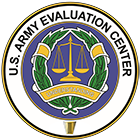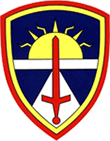- Homepage >
- Organization >
- History

AEC's mission, in partnership with ATEC Test Centers and Operational Test Command is to plan and conduct independent, integrated evaluations to determine and report the effectiveness, suitability and survivability of assigned systems.
History
On November 18, 1998, the Vice Chief of Staff of the Army approved consolidation of developmental and operational testing. That decision led to the redesignation, on October 1, 1999, of the Operational Test and Evaluation Command (OPTEC) to ATEC. Central to the consolidation was ATEC assuming overall responsibility for all Army developmental and operational testing. The Test and Evaluation command (TECOM) became a major subordinate command of ATEC and was redesignated the U.S. Army Developmental Test Command (DTC), with DTC headquarters remaining at Aberdeen Proving Ground, Maryland. Also, the Test and Experimentation Command (TEXCOM) was redesignated the U.S. Army Operational Test Command (OTC), with OTC headquarters remaining at Fort Hood, Texas. The third ATEC subordinate command that was redesignated encompassed both the Operational Evaluation Command and the Evaluation Analysis Center, which were combined to form the new U.S. Army Evaluation Center (AEC), completing the earlier decision to move developmental and operational evaluation into a single, integrated command.
OEC, headquartered in Alexandria, VA was established under the Operational Test and Evaluation Command (OPTEC) in November 1990 using the resources of the Operational Test and Evaluation Agency (OTEA). OTEA was established in 1972 in response to a 1971 Blue Ribbon Report that stressed the need for changes in the Army's conduct of operational testing and evaluation. The command of OTEA reported directly to the Vice Chief of Staff of the Army. EAC, headquartered in Aberdeen Proving Ground, MD was established in 1996, when the Vice Chief of Staff of the Army, based on recommendations from the Army Science Board Study and the Headquarters Department of the Army Redesign Functional Area Analysis, consolidated the Army Materiel Command's (AMC) missions, functions, responsibilities, and resources for independent developmental evaluations, assessments and associated analysis under OPTEC. The consolidation, which formally took place on 1 October 1996, affected personnel within three AMC organizations - the Army Materiel Systems Analysis Activity (AMSAA), the Survivability and Lethality Analysis Directorate (SLAD) of the Army Research Lab, and U.S. Army Test and Evaluation Command (TECOM).
As a result of BRAC 2005, ATEC headquarters and the U.S. Army Evaluation Center located in Alexandria, Va., were directed to relocate to APG and to consolidate with elements of the command stationed there by Sept. 15, 2011. ATEC, DTC and AEC headquarters staffs were consolidated to allow for the elimination of redundant positions. DTC was disestablished as the test management and safety validation missions and were reassigned to AEC to strengthen the test expertise of the command's evaluators and improve integration and coordination between developmental testing and operational testing. The AEC flag level leadership now includes a general officer as well as a member of the Senior Executive Service. This reorganization is improving integration and coordination between developmental and operational testing; allowing identification, early-on, of those specific tests whose results will support safety and program decision making while maintaining an acceptable level of program risk.
In 2013, AEC reorganized to increase our developmental evaluation capabilities, refine our acquisition system evaluation processes and maintain our safety assessments and operational evaluations in support of the Army 2013 strategic guidance. The prior organization was postured to support legacy Army mission requirements with an increased Operational Tempo (OPTEMPO) and development of rapid acquisition system capabilities. As the Army transforms to be more agile, expeditionary and cost efficient, AEC reorganized to better support AEC's assigned mission of assessing system effectiveness, suitability and survivability through focused evaluation of system technology improvements leading to increased operational capabilities.


